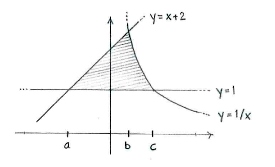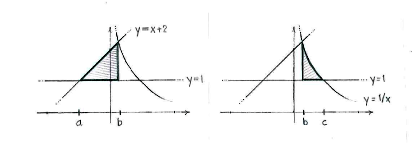Solution 2.1:4d
From Förberedande kurs i matematik 2
(Ny sida: {{NAVCONTENT_START}} <center> Bild:2_1_4d-1(5).gif </center> {{NAVCONTENT_STOP}} {{NAVCONTENT_START}} <center> Bild:2_1_4d-2(5).gif </center> {{NAVCONTENT_STOP}} {{NAVCONTENT_START}...) |
m |
||
| (5 intermediate revisions not shown.) | |||
| Line 1: | Line 1: | ||
| - | + | We start by drawing the three curves: | |
| - | + | ||
| - | {{ | + | [[Image:2_1_4_d1.gif|center]] |
| - | {{ | + | |
| - | < | + | When we draw the curves on the same diagram, we see that the region is bounded from below in the ''y''-direction by the horizontal line <math>y=1</math> and above partly by <math>y=x+2</math> and partly by <math>y=1/x\,</math>. |
| - | {{ | + | |
| - | {{ | + | [[Image:2_1_4_d2.gif|center]] |
| - | < | + | |
| - | {{ | + | If we denote the ''x''-coordinates of the intersection points between the curves by <math>x=a</math>, <math>x=b</math> and <math>x=c</math>, as shown in the figure, we see that the region can be divided up into two parts. In the left part between <math>x=a</math> and <math>x=b</math>, the upper limit is <math>y=x+2</math>, whilst in the right part between <math>x=b</math> and <math>x=c</math> the curve <math>y=1/x</math> is the upper limit. |
| - | {{ | + | |
| - | + | [[Image:2_1_4_d3.gif|center]] | |
| - | {{ | + | |
| - | {{ | + | The area of each part is given by the integrals |
| - | + | ||
| - | {{ | + | {{Displayed math||<math>\begin{align} |
| + | \text{Left area} &= \int\limits_a^b (x+2-1)\,dx\,,\\[5pt] | ||
| + | \text{Right area} &= \int\limits_b^c \Bigl(\frac{1}{x}-1\Bigr)\,dx\,, | ||
| + | \end{align}</math>}} | ||
| + | |||
| + | and the total area is the sum of these areas. | ||
| + | |||
| + | If we just manage to determine the curves' points of intersection, the rest is just a matter of integration. | ||
| + | |||
| + | To determine the points of intersection: | ||
| + | |||
| + | *<math>x=a</math>: The point of intersection between <math>y=1</math> and <math>y=x+2</math> must satisfy both equations of the lines, | ||
| + | |||
| + | {{Displayed math||<math>\left\{\begin{align} | ||
| + | y &= 1\,,\\[5pt] | ||
| + | y &= x+2\,\textrm{.} | ||
| + | \end{align}\right.</math>}} | ||
| + | |||
| + | :This gives that <math>x</math> must satisfy <math>x+2=1</math>, i.e. <math>x=-1\,</math>. Thus, <math>a=-1\,</math>. | ||
| + | |||
| + | |||
| + | *<math>x=b</math>: At the point where the curves <math>y=x+2</math> and <math>y=1/x</math> meet, we have that | ||
| + | |||
| + | {{Displayed math||<math>\left\{\begin{align} | ||
| + | y &= x+2\,,\\[5pt] | ||
| + | y &= 1/x\,\textrm{.} | ||
| + | \end{align}\right.</math>}} | ||
| + | |||
| + | :If we eliminate <math>y</math>, we obtain an equation for <math>x</math>, | ||
| + | |||
| + | {{Displayed math||<math>x+2=\frac{1}{x}\,,</math>}} | ||
| + | |||
| + | :which we multiply by <math>x</math>, | ||
| + | |||
| + | {{Displayed math||<math>x^{2}+2x=1\,\textrm{.}</math>}} | ||
| + | |||
| + | :Completing the square of the left-hand side, | ||
| + | |||
| + | {{Displayed math||<math>\begin{align} | ||
| + | (x+1)^2 - 1^2 &= 1\,,\\[5pt] | ||
| + | (x+1)^2 &= 2\,, | ||
| + | \end{align}</math>}} | ||
| + | |||
| + | :and taking the square root gives that <math>x=-1\pm \sqrt{2}</math>, leading to | ||
| + | <math>b=-1+\sqrt{2}</math>. (The alternative <math>b=-1-\sqrt{2}</math> | ||
| + | lies to the left of <math>x=a\,</math>.) | ||
| + | |||
| + | |||
| + | *<math>x=c</math>: The final point of intersection is given by the condition that the equation to both curves, <math>y=1</math> and <math>y=1/x\,</math>, are satisfied simultaneously. We see almost immediately that this gives <math>x=1\,</math>, i.e. <math>c=1\,</math>. | ||
| + | |||
| + | |||
| + | The sub-areas are | ||
| + | |||
| + | {{Displayed math||<math>\begin{align} | ||
| + | \text{Left area} | ||
| + | &= \int\limits_{-1}^{\sqrt{2}-1} (x+2-1)\,dx\\[5pt] | ||
| + | &= \int\limits_{-1}^{\sqrt{2}-1} (x+1)\,dx\\[5pt] | ||
| + | &= \Bigl[\ \frac{x^2}{2} + x\ \Bigr]_{-1}^{\sqrt{2}-1}\\[5pt] | ||
| + | &= \frac{\bigl(\sqrt{2}-1\bigr)^2}{2} + \sqrt{2} - 1 - \Bigl(\frac{(-1)^2}{2} + (-1) \Bigr)\\[5pt] | ||
| + | &= \frac{\bigl(\sqrt{2}\bigr)^2-2\sqrt{2}+1}{2} + \sqrt{2} - 1 - \frac{1}{2} + 1\\[5pt] | ||
| + | &= \frac{2-2\sqrt{2}+1}{2} + \sqrt{2} - 1 - \frac{1}{2} + 1\\[5pt] | ||
| + | &= 1 - \sqrt{2} + \frac{1}{2} + \sqrt{2} - 1 - \frac{1}{2} + 1\\[5pt] | ||
| + | &= 1\,,\\[10pt] | ||
| + | \text{Right area} | ||
| + | &= \int\limits_{\sqrt{2}-1}^1 \Bigl(\frac{1}{x}-1\Bigr)\,dx\\[5pt] | ||
| + | &= \Bigl[\ \ln |x| - x\ \Bigr]_{\sqrt{2}-1}^1\\[5pt] | ||
| + | &= \ln 1 - 1 - \Bigl( \ln \bigl(\sqrt{2}-1\bigr)-\bigl(\sqrt{2}-1\bigr)\Bigr)\\[5pt] | ||
| + | &= 0 - 1 - \ln \bigl(\sqrt{2}-1\bigr) + \sqrt{2} - 1\\[5pt] | ||
| + | &= \sqrt{2} - 2 - \ln\bigl(\sqrt{2}-1\bigr)\,\textrm{.} | ||
| + | \end{align}</math>}} | ||
| + | |||
| + | The total area is | ||
| + | |||
| + | {{Displayed math||<math>\begin{align} | ||
| + | \text{Area} | ||
| + | &= \text{(left area)} + \text{(right area)}\\[5pt] | ||
| + | &= 1 + \sqrt{2} - 2 - \ln\bigl(\sqrt{2}-1\bigr)\\[5pt] | ||
| + | &= \sqrt{2} - 1 - \ln\bigl(\sqrt{2}-1\bigr)\,\textrm{.} | ||
| + | \end{align}</math>}} | ||
Current revision
We start by drawing the three curves:
When we draw the curves on the same diagram, we see that the region is bounded from below in the y-direction by the horizontal line \displaystyle y=1 and above partly by \displaystyle y=x+2 and partly by \displaystyle y=1/x\,.
If we denote the x-coordinates of the intersection points between the curves by \displaystyle x=a, \displaystyle x=b and \displaystyle x=c, as shown in the figure, we see that the region can be divided up into two parts. In the left part between \displaystyle x=a and \displaystyle x=b, the upper limit is \displaystyle y=x+2, whilst in the right part between \displaystyle x=b and \displaystyle x=c the curve \displaystyle y=1/x is the upper limit.
The area of each part is given by the integrals
| \displaystyle \begin{align}
\text{Left area} &= \int\limits_a^b (x+2-1)\,dx\,,\\[5pt] \text{Right area} &= \int\limits_b^c \Bigl(\frac{1}{x}-1\Bigr)\,dx\,, \end{align} |
and the total area is the sum of these areas.
If we just manage to determine the curves' points of intersection, the rest is just a matter of integration.
To determine the points of intersection:
- \displaystyle x=a: The point of intersection between \displaystyle y=1 and \displaystyle y=x+2 must satisfy both equations of the lines,
| \displaystyle \left\{\begin{align}
y &= 1\,,\\[5pt] y &= x+2\,\textrm{.} \end{align}\right. |
- This gives that \displaystyle x must satisfy \displaystyle x+2=1, i.e. \displaystyle x=-1\,. Thus, \displaystyle a=-1\,.
- \displaystyle x=b: At the point where the curves \displaystyle y=x+2 and \displaystyle y=1/x meet, we have that
| \displaystyle \left\{\begin{align}
y &= x+2\,,\\[5pt] y &= 1/x\,\textrm{.} \end{align}\right. |
- If we eliminate \displaystyle y, we obtain an equation for \displaystyle x,
| \displaystyle x+2=\frac{1}{x}\,, |
- which we multiply by \displaystyle x,
| \displaystyle x^{2}+2x=1\,\textrm{.} |
- Completing the square of the left-hand side,
| \displaystyle \begin{align}
(x+1)^2 - 1^2 &= 1\,,\\[5pt] (x+1)^2 &= 2\,, \end{align} |
- and taking the square root gives that \displaystyle x=-1\pm \sqrt{2}, leading to
\displaystyle b=-1+\sqrt{2}. (The alternative \displaystyle b=-1-\sqrt{2} lies to the left of \displaystyle x=a\,.)
- \displaystyle x=c: The final point of intersection is given by the condition that the equation to both curves, \displaystyle y=1 and \displaystyle y=1/x\,, are satisfied simultaneously. We see almost immediately that this gives \displaystyle x=1\,, i.e. \displaystyle c=1\,.
The sub-areas are
| \displaystyle \begin{align}
\text{Left area} &= \int\limits_{-1}^{\sqrt{2}-1} (x+2-1)\,dx\\[5pt] &= \int\limits_{-1}^{\sqrt{2}-1} (x+1)\,dx\\[5pt] &= \Bigl[\ \frac{x^2}{2} + x\ \Bigr]_{-1}^{\sqrt{2}-1}\\[5pt] &= \frac{\bigl(\sqrt{2}-1\bigr)^2}{2} + \sqrt{2} - 1 - \Bigl(\frac{(-1)^2}{2} + (-1) \Bigr)\\[5pt] &= \frac{\bigl(\sqrt{2}\bigr)^2-2\sqrt{2}+1}{2} + \sqrt{2} - 1 - \frac{1}{2} + 1\\[5pt] &= \frac{2-2\sqrt{2}+1}{2} + \sqrt{2} - 1 - \frac{1}{2} + 1\\[5pt] &= 1 - \sqrt{2} + \frac{1}{2} + \sqrt{2} - 1 - \frac{1}{2} + 1\\[5pt] &= 1\,,\\[10pt] \text{Right area} &= \int\limits_{\sqrt{2}-1}^1 \Bigl(\frac{1}{x}-1\Bigr)\,dx\\[5pt] &= \Bigl[\ \ln |x| - x\ \Bigr]_{\sqrt{2}-1}^1\\[5pt] &= \ln 1 - 1 - \Bigl( \ln \bigl(\sqrt{2}-1\bigr)-\bigl(\sqrt{2}-1\bigr)\Bigr)\\[5pt] &= 0 - 1 - \ln \bigl(\sqrt{2}-1\bigr) + \sqrt{2} - 1\\[5pt] &= \sqrt{2} - 2 - \ln\bigl(\sqrt{2}-1\bigr)\,\textrm{.} \end{align} |
The total area is
| \displaystyle \begin{align}
\text{Area} &= \text{(left area)} + \text{(right area)}\\[5pt] &= 1 + \sqrt{2} - 2 - \ln\bigl(\sqrt{2}-1\bigr)\\[5pt] &= \sqrt{2} - 1 - \ln\bigl(\sqrt{2}-1\bigr)\,\textrm{.} \end{align} |



